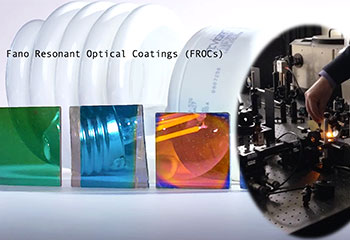 As seen in The Daily: October 23, 2023
As seen in The Daily: October 23, 2023
Revolutionizing Color Technology and Solar Energy
(Cleveland, Ohio) Case Western Reserve University physicists are developing ultra-thin optical coatings that could dramatically extend the life of solar panels, as well as improve areas like data storage, or protection against counterfeiting.
“Imagine a world where surfaces not only display vibrant colors, but also serve as efficient energy-harvesting platforms,” said Case Western Reserve physics professor Giuseppe Strangi. “That is the world which we are bringing to light.”
Strangi is leading a research group developing the new optical coatings, which are as thin as a few atomic layers. They can simultaneously transmit and reflect narrow-banded light with unparalleled vividness and purity of the colors.
“They act like as very selective transparent windows and as reflective mirrors,” Strangi said, “and this precision empowers us to manipulate the appearance of reflected light.”

Giuseppe Strangi, Professor and Ohio Research Scholar in Surfaces of Advanced Materials
Lengthening the life of solar panels
The most promising possible application for the new optical coatings is extending the life of solar panels, Strangi said.
Solar panels typically last about 20 to 30 years. Among the reasons: Sunlight provides energy but also heats the panel, reducing its short-term efficiency and long-term durability as it breaks down the materials.
That’s because there are two specific bands in the light energy: One (photovoltaic) can be stored as energy, while the other (thermal) heats the panel.

Michael Hinczewski, Associate Professor
“But, until now, you couldn’t discriminate between the two, so to get the energy, you’d also have to accept the heat,” Strangi said. “Our coatings separate the two, leading a power generation increase in the short term and a sixfold increase in the lifetime of the panel.”
Case Western Reserve obtained a patent on the new materials, Strangi said.
The research group—which includes CWRU physics professor Michael Hinczewski and collaborators at MIT, the University of Arizona and the University of Rochester—is also working with industrial collaborators in the United States and Finland to explore scaling up the technology.
Their findings were recently published in the journal Nature Communications. This most recent work built on the group’s original findings, published in 2021 in Nature Nanotechnology, on what they dubbed “Fano resonant optical coatings.”
Ugo Fano’s legacy of light

The new materials are named for Ugo Fano, an Italian physicist who worked with Enrico Fermi on fission experiments in the 1930s.
Fano’s unique insights were into something called “spectral line shapes,” or visualization of the energy change in a molecule or even a single atom. Strangi’s team has been able to manipulate those Fano line shapes—so, the energy—by bounding discrete states in the continuum using thin film photonics.
Other applications for the new research are varied: New “structural coloring” advances would improve computer display technologies, increase data storage, improve anti-counterfeiting measures and even allow for more variations in decor, Strangi said.
